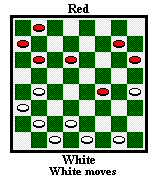Return to my Checkers pages
Go to my home page
J.Childers-J.Loy, 1999 I-D
© Copyright 2000, Jim Loy
You may print this and show it to others. But, this article will eventually be
part of a book that I am writing. So, please do not distribute it widely.
If you need help reading checkers notation, please print out the
numbered board.
After this game (and a couple others in the notes below), there was a rumor
that I had busted this opening (the Skunk). I don't think that I have busted
the opening. My opponent, Jerry Childers (former World Checkers-by-Mail Champ),
seems to have made a mistake. The previous two years, I had great difficulty
defending from the weak side (Red) of this opening. Studying the published
play, I didn't see why some moves lost, and why others drew. They all seemed to
lose, when I tried them. I thought that the opening might lose. But, after
dozens of pages (and hundreds of hours) of inconclusive analysis, I now think
the opening draws. And I still do not know why some moves lose and others draw.
J.Childers-J.Loy, 1999 I-D (Inter-District Checkers-by-Mail
Tourney), game #4
12-16 24-20 10-15 (The Skunk, one of the formerly barred openings) 22-18
15-22 25-18 11-15 18-11 8-15 20-11 7-16 23-19 16-23 27-11 3-8 11-7 2-11 21-17
8-12(A) 29-25 4-8 28-24(C) 11-15 (maybe something else draws) 24-20
15-19 (May lose. I think that 6-10 is better) 25-21 6-10 (9-13 17-14
WW?) [diagram]
 White seems to win with:
20-16! (My computer couldn't find this. At first, I thought I was going
to win the bridge ending) 9-14 (9-13 17-14 WW?) 31-27 19-24 27-20
12-19 20-16 19-24 16-12 8-11 12-8 11-15 8-3 15-18 3-7 (Just in time to
immobilize these pieces while Red destroys White's bridge) 24-27 32-23 18-27
26-23* (Apparently, White must delay 17-13) 27-31 23-19* 31-27 17-13*
27-23 19-16 23-19 16-11 WW(D).
White seems to win with:
20-16! (My computer couldn't find this. At first, I thought I was going
to win the bridge ending) 9-14 (9-13 17-14 WW?) 31-27 19-24 27-20
12-19 20-16 19-24 16-12 8-11 12-8 11-15 8-3 15-18 3-7 (Just in time to
immobilize these pieces while Red destroys White's bridge) 24-27 32-23 18-27
26-23* (Apparently, White must delay 17-13) 27-31 23-19* 31-27 17-13*
27-23 19-16 23-19 16-11 WW(D).
A - 11-15? (the published way, and may lose) 28-24 8-11 (J.Loy-B.Vanderpool,
1998 I-D went: 6-10 29-25 8-12 26-23 4-8 25-21 8-11 same) 29-25 4-8 26-23 6-10
25-21 8-12 (We have transposed into the previously published
J.Loy-B.Vanderpool, 1998 I-D, where Bert won with the following innovation)
30-26! (32-27 drew, T.Sheehan-B.Vanderpool, 1998 I-D, setting up Tom for a loss
to me a year later) 12-16(B) 17-13 10-14
13-6 1-10 32-28 15-18 31-27 WW T.Sheehan-J.Loy, 1999 I-D. No one seemed to know
about the transposition.
B (off A) - 9-13 32-27 13-22 26-17 1-6 (12-16 17-14 WW) 24-20 (WW
J.Loy-B.Vanderpool, 1998 I-D) 6-9 17-13 9-14 13-9 15-18 9-6 18-22 6-2 WW
W.Schumann-J.Loy, 1999 I-D.
C - 25-22 (I thought that this won) 6-10 17-13 9-14 (10-14? 13-6 1-10 28-24
11-16 24-19 16-23 26-19 5-9 30-25 8-11 31-26 11-16 26-23 10-15 19-10 16-19
23-16 12-19 32-27 19-23 27-18 14-23 WW K.Wold-J.Loy, 1999 I-D) 13-9 14-17 22-13
5-14 26-23 1-6 28-24 11-15 24-20 draw Vanderpool-Loy 1999 I-D. Once this draw
became obvious, I began studying 28-24 at note C.
D - Continue: 19-15 (10-15 13-9 WW) 11-8 15-19 8-3 19-15 13-9 WW.
I took my time getting around to annotating this game, as I am not sure of
some of the above analysis. Does note A lose? Is there really a way to save
Jerry's game before the diagram?
Return to my Checkers pages
Go to my home page
 White seems to win with:
20-16! (My computer couldn't find this. At first, I thought I was going
to win the bridge ending) 9-14 (9-13 17-14 WW?) 31-27 19-24 27-20
12-19 20-16 19-24 16-12 8-11 12-8 11-15 8-3 15-18 3-7 (Just in time to
immobilize these pieces while Red destroys White's bridge) 24-27 32-23 18-27
26-23* (Apparently, White must delay 17-13) 27-31 23-19* 31-27 17-13*
27-23 19-16 23-19 16-11 WW(D).
White seems to win with:
20-16! (My computer couldn't find this. At first, I thought I was going
to win the bridge ending) 9-14 (9-13 17-14 WW?) 31-27 19-24 27-20
12-19 20-16 19-24 16-12 8-11 12-8 11-15 8-3 15-18 3-7 (Just in time to
immobilize these pieces while Red destroys White's bridge) 24-27 32-23 18-27
26-23* (Apparently, White must delay 17-13) 27-31 23-19* 31-27 17-13*
27-23 19-16 23-19 16-11 WW(D).